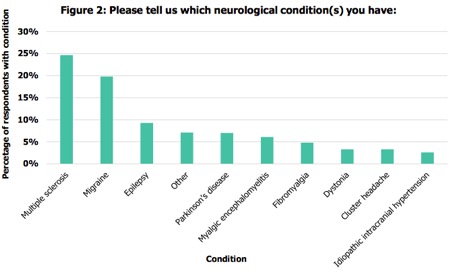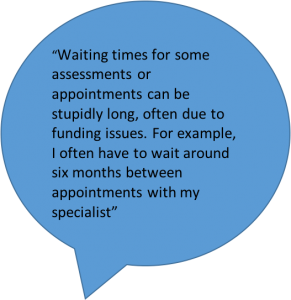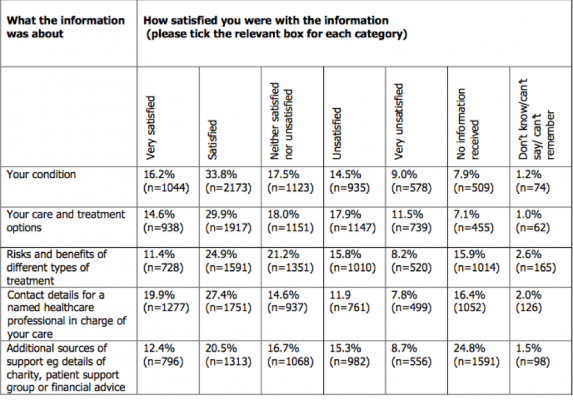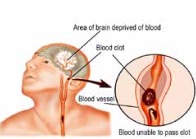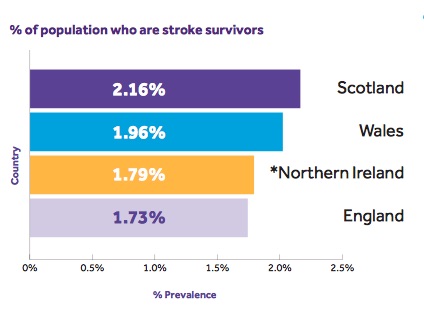Neurological Physiotherapy in Private Practice: Difference between revisions
Sonja Murphy (talk | contribs) No edit summary |
Sonja Murphy (talk | contribs) No edit summary |
||
| Line 170: | Line 170: | ||
Within Lothian, it is estimated that there are 1,698 first or recurrent strokes per year, along with a further 340 people experiencing a transient ischemic attack, and 6,112 people living with stroke <ref name="Lothian Improvement Plan" />.<br> | Within Lothian, it is estimated that there are 1,698 first or recurrent strokes per year, along with a further 340 people experiencing a transient ischemic attack, and 6,112 people living with stroke <ref name="Lothian Improvement Plan" />.<br> | ||
<u>''NHS STROKE SERVICES''</u> | |||
<u>''<br>''</u>The NHS Physiotherapy waiting times, workforce and caseloads survey in the UK in 2010-2011 asked the question “Do you provide a stroke service?”. Sixty-seven respondents answered the question to show overall that 42% provided an inpatient stroke service, 34% did not provide any physiotherapy for stroke, 16% provided both community and inpatient stroke services, and 8% only provided a community stroke service. <br>The Scottish Stroke Care Audit 2012 identified clear standards for stroke services in Scottish hospitals to achieve. Standard one and two is at least 60% of patients with stroke admitted to the hospital should enter the stroke unit on the day of arrival and at least 90% of stroke patients should be admitted to the stroke unit on the day they arrive or the day after. The tables below show the Scottish hospitals that did not meet standards one and two in 2011. <br>Standard 1:<br> | |||
<br> | <br> | ||
Revision as of 23:55, 1 November 2016
NEUROLOGICAL PHYSIOTHERAPY[edit | edit source]
Neurological Physiotherapy is a specialist area of physiotherapy focused on the treatment of individuals with neurological conditions. Neurological disorders affect the functioning of the brain, spinal cord, and nerves. Stroke, multiple sclerosis, spinal cord injury and Parkinson’s disease are common neurological conditions [1]. It also includes conditions of the peripheral nervous system such as Guillain Barre Syndrome. Neurological conditions can have a devastating impact on the lives of the sufferers, along with family and friends. Disturbances in the travelling of messages between the brain and the body can result in the loss of movement, sensation, co-ordination, and balance. Other aspects of bodily function, such as perception, speech, memory, cognition, and behaviour may also be effected. Therefore, it is important that neurological physiotherapists work in close partnership with other members of the multidisciplinary team including speech and language therapists, occupational therapist, dieticians, nurses, and doctors. Effective communication between patient, family members, and the multidisciplinary team is critical to positive healthcare outcomes following a neurological disorder [2].
AIM OF NEUROLOGICAL PHYSIOTHERAPY
Neurological Physiotherapy aims to provide interventions which assist an individual to regain or maintain the maximum movement and functional independence by aiding in the development of new pathways through repetition and exercise.
TREATMENT INTERVENTIONS
A number of treatment approaches are used, often incorporating a selection of the following as appropriate [2]
Stretching
Strengthening
Balance re-education
Gait re-education
Joint mobilization
Electrical stimulation
Postural exercise
Spasticity management
Advice/Education on lifestyle, fatigue management, and exercise
PREVALENCE OF NEUROLOGICAL CONDITIONS[edit | edit source]
The Neurological Alliance [3] reported the total number of neurological cases in England to be 12.5 million or 59,000 cases per CCG in 2013-14, with a further 1 million cases in Scotland reported in the NHS QIS Clinical Standards on Neurological Health Services [4].
Figure 1:
Figure 1[5] represents the most common neurological conditions in England.
Image 1 illustrates the number of neurological conditions and the distribution of cases between progressive, intermittent, stable with changing needs, and sudden onset.
Image 1[3]:
Within NHS Lothian, it is estimated that 53,480 people are living with a neurological condition. The number of people disabled by the condition is 5,348 and an estimated 1,872 people will need assistance carrying out activities of daily living. Each year, a further 8,489 people in Lothian will be diagnosed with a neurological condition [6]
PUBLIC PERCEPTIONS OF NEUROLOGICAL CONDITIONS[edit | edit source]
A study conducted by Sue Ryder revealed that 45% of the UK population feared being impacted by a neurological condition the most which is compared to 36% who feared getting cancer. The study highlighted the beliefs of the public with regards to neurological conditions, showing that 26% of the public felt that “nothing much can be done” for people with neurological conditions [7]. It is understandable why the general public fear being effected by a neurological condition when one takes into consideration patients poor experience with neurological healthcare. The Neurological Alliance conducted a neurological patient experience survey in 2014 [5].
Figure 1 illustrates the population responding to this survey
Figure 2 indicates the neurological conditions represented in the survey.
The survey stated that 58.1% (n=3402) of NHS England respondents (n=6916) have experienced difficulty accessing the service/treatment they require, 39.8% (n= 2357) of respondents had a 12-month waiting period from the time of observation of the first symptom to seeing a neurologist specialist, 31.5% of respondents (n=2140) had 5 or more GP visits related to the health problems experienced due to their condition prior to being referred to a neurological specialist, and 71.5% (n=4603) of respondents were not provided with a care plan to help manage their condition [5].
WAITING TIMES FOR NHS NEUROLOGICAL SERVICES[edit | edit source]
The 2005 National Service Framework for Long-term Conditions [8] identified the need for prioritising an accurate and rapid diagnosis of neurological conditions, highlighting the importance of early diagnosis within this clinical population to reduce neurological damage, delay disease progression, elevate survival numbers, and enhance patient’s quality of life. However, it appears in 2014 that this call to action had not been achieved with 3,402 respondents to the neurological patient experience survey [5] voicing concerns regarding challenges experienced trying to access the treatment and services they needed.
Respondents opinions emphasized the concern of long waiting times especially transitioning from general practice to specialist care settings.
In December 2011, a survey of NHS Physiotherapy waiting times[9] in the UK was published, showing that in neurology departments, the longest wait reported was 2-4 weeks and 83% of neurological patients were seen in 8 weeks or less. The shortest wait was less than a week and the longest wait was 18-20 weeks.
NHS PATIENT INVOLVEMENT IN DECISION MAKING[edit | edit source]
Only 34.1% of Clinical commissioning groups which responded to the quality of commissioning audit, utilise mechanisms to involve patients in decision-making processes and only 33% obtain important feedback on the services they provide. Taking into consideration the NHS principle of “no decision about me without me” [10], the NHS must actively incorporate patient views in the design and provision of services. The chart below [5] highlights the high number of neurological patients receiving no information from healthcare professionals on various aspects of patient care. Without crucial information, how is it possible for patients to make educated, informed decisions about their healthcare?
STROKE[edit | edit source]
WHAT IS A STROKE?
A stroke is a type of cerebrovascular disease. A stroke occurs when the blood supply to part of the brain is disrupted, depriving brain cells of oxygen and nutrients.
The two types of stroke are [11]:
1. Ischemic stroke: A blood clot interrupts the blood supply to the brain. Blockages may be due to atherosclerosis, small vessel disease, arterial dissection, or a heart condition. A blood clot may be treated with thrombolysis, which is a clot busting medication. Thrombolysis needs to be given within 4.5 hours of the onset of the first stroke symptom in order to have the optimum effect. This medication can break down and disperse a clot, helping to regain the blood supply to the brain.
2. Haemorrhagic stroke: This type of stroke occurs when a blood vessel ruptures causing bleeding in the brain. The bleeding may occur within the brain, known as an intracerebral haemorrhage or blood can leak into the subarachnoid space, known as a subarachnoid haemorrhage. Symptoms of an intracerebral haemorrhage may include loss of consciousness, nausea, muscle weakness on one side of the body, or severe headache, a subarachnoid haemorrhage causes a sudden onset of symptoms, including a severe headache, loss of consciousness, vomiting, or neck stiffness. A ruptured blood vessel may be caused by high blood pressure, cerebral amyloid angiopathy, an aneurysm, anticoagulant medication, or drugs such as cocaine. A haemorrhagic stroke may need surgery to stop the bleeding, relieve pressure, or remove blood around the brain. This operation is known as a craniotomy. Medication to lower blood pressure or slow down the bleeding may be prescribed.
A transient ischemic attack is similar to a stroke but the symptoms last less than 24 hours. It acts as a warning sign for being at risk of a full stroke.
HOW IS A STROKE DIAGNOSED?
A stroke is usually diagnosed using a brain scan, either a magnetic resonance imaging scan or a computed tomography scan. If the patient has had a subarachnoid haemorrhage, a lumbar puncture may be carried out in addition to a brain scan to remove fluid around the spinal cord to determine if any blood has leaked into it [12].
STROKE PREVALENCE IN THE UK
A stroke occurs every 3 minutes and 27 seconds in the UK, totalling approximately 152,000 strokes a year [13] . There is a high prevalence of stroke in Scotland due to the risk factors linked with the condition, including hypertension, smoking, inadequate exercise, high levels of alcohol consumption, and a poor diet. The Scottish Health survey 2014 revealed a shocking figure of 3.3% of males and 3.1% of females reported to have suffered from a stroke. In 2014/2015, 10,306 females and 10,310 males were discharged from hospital with stroke in Scotland. The percentage of stroke patients surviving 30 days or more after first emergency admission has improved very slightly from 81.6% in 2005/2006 to 84.9% in 2014/2015.[14] Scotland has the highest percentage of stroke survivors, meaning a large population of people requiring support and therapy post-stroke. This places addtitional stress on resources within NHS Scotland [13] .
Within Lothian, it is estimated that there are 1,698 first or recurrent strokes per year, along with a further 340 people experiencing a transient ischemic attack, and 6,112 people living with stroke [6].
NHS STROKE SERVICES
The NHS Physiotherapy waiting times, workforce and caseloads survey in the UK in 2010-2011 asked the question “Do you provide a stroke service?”. Sixty-seven respondents answered the question to show overall that 42% provided an inpatient stroke service, 34% did not provide any physiotherapy for stroke, 16% provided both community and inpatient stroke services, and 8% only provided a community stroke service.
The Scottish Stroke Care Audit 2012 identified clear standards for stroke services in Scottish hospitals to achieve. Standard one and two is at least 60% of patients with stroke admitted to the hospital should enter the stroke unit on the day of arrival and at least 90% of stroke patients should be admitted to the stroke unit on the day they arrive or the day after. The tables below show the Scottish hospitals that did not meet standards one and two in 2011.
Standard 1:
References
- ↑ NEUROLOGICAL ALLIANCE OF SCOTLAND.,2016. Neurological conditions factsheet [online]. [viewed 31 October 2016]. Available from: http://www.scottishneurological.org.uk/content/res/Neurological_Conditions_Factsheet.pdf
- ↑ 2.0 2.1 NEUROLOGICAL PHYSIOTHERAPY., 2016. Neurological physiotherapy [online]. [viewed 31 October 2016]. Available from: http://neurologicalphysiotherapy.com Cite error: Invalid
<ref>tag; name "Neurological Physiotherapy" defined multiple times with different content - ↑ 3.0 3.1 THE NEUROLOGICAL ALLIANCE., 2014. Neurological alliance neuro numbers [online]. London: The Neurological Alliance. [viewed 31 October 2016]. Available from: http://www.neural.org.uk/store/assets/files/381/original/Final_-_Neuro_Numbers_30_April_2014_.pdf
- ↑ NATIONAL HEALTH SERVICE QUALITY IMPROVEMENT SCOTLAND., 2009. Neurological health services: Clinical standards.
- ↑ 5.0 5.1 5.2 5.3 5.4 THE NEUROLOGICAL ALLIANCE., 2015.The invisible patients: revealing the state of neurology services [online]. London: The Neurological Alliance. pp. 1-69.[viewed 31 October 2016]. Available from: http://www.neural.org.uk/store/assets/files/495/original/Invisible_patients_-_revealing_the_state_of_neurology_services_final_14_January_2015_.pdf
- ↑ 6.0 6.1 NATIONAL HEALTH SERVICE LOTHIAN., 2015. Lothian neurological care improvement plan 2014 to 2017 [online]. [viewed 31 October 2016]. Available from: http://www.nhslothian.scot.nhs.uk/OurOrganisation/Strategies/Documents/NHS%20Lothian%20Neurological%20Care%20Improvement%20Plan%202014-2017%20-%20Final.pdf
- ↑ SUE RYDER., 2016. Public fear getting a neurological condition [online].[viewed 31 October 2016]. Available from: http://www.sueryder.org/media-centre/news/2016/june/public%20fear%20getting%20a%20neurological%20disorder
- ↑ DEPARTMENT OF HEALTH., 2005. The national service framework for longterm conditions. Leeds: NSF.
- ↑ JJ CONSULTING., 2011. A survey of NHS Physiotherapy waiting times, workforce and caseloads in the UK 2010-2011. London: CSP.
- ↑ DEPARTMENT OF HEALTH., 2012. Liberating the NHS:No decision about me, without me. London:NHS
- ↑ STROKE ASSOCIATION, 2015. What is a stroke? [online].[viewed 1 November 2016]. Available from: https://www.stroke.org.uk/what-stroke/what-stroke
- ↑ NEUROSCIENCE., 2010. Subarachnoid haemorrhage [online]. Bristol: NHS Trust. pp. 1-10. [viewed 1 November 2016]. Available from: https://www.nbt.nhs.uk/sites/default/files/attachments/Subarachnoid%20Haemorrhage_NBT002126.pdf
- ↑ 13.0 13.1 "STROKE ASSOCIATION., 2016. State of the nation: stroke statistics [online]. [viewed 1 November 2016]. Available from: https://www.stroke.org.uk/sites/default/files/stroke_statistics_2015.pdf Cite error: Invalid
<ref>tag; name "2016 stroke statistics" defined multiple times with different content - ↑ NATIONAL HEALTH SERVICE SCOTLAND., 2016. Scottish stroke statistics [online]. [viewed 1 November 2016]. Available from: https://www.isdscotland.org/Health-Topics/Stroke/Publications/2016-01-26/2016-01-26-Stroke-Report.pdf



